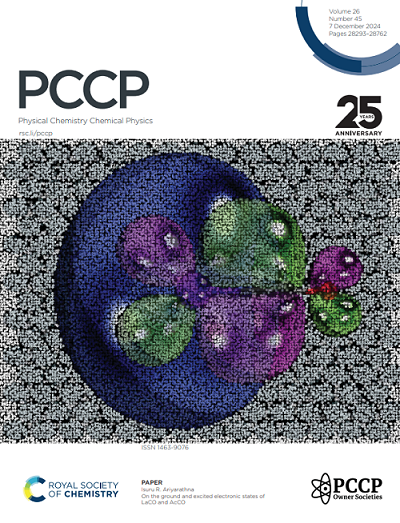Tunable electrocatalytic nitrogen reduction reactions via polarization switching on In2Se3-based single-atom catalysts.
IF 2.9
3区 化学
Q3 CHEMISTRY, PHYSICAL
引用次数: 0
Abstract
The tunability of two-dimensional (2D) ferroelectric-based single-atom catalysts shows great potential in electrocatalytic nitrogen reduction reactions (NRRs). This work systematically investigates the influence of polarization switching on the NRR performance of transition metal (TM) adsorbed α-In2Se3 monolayers using first-principles calculations. Obviously, polarization switching in the α-In2Se3 monolayer can cause the redistribution of electrons between TM atoms and intermediates, thereby altering the adsorption strength and energy barrier. After the screening of stability, catalytic activity, and selectivity, Re@P↑-In2Se3 and Mo@P↑-In2Se3 systems exhibit outstanding catalytic activity with a limiting potential UL of -0.39 V, surpassing that (-0.50 V) of the excellent NRR electrocatalyst Re (111). In addition, correlations between the UL and three descriptors E*NNH, E*NH2, and Mt (total magnetic moment) are established to explore the trend of changes in NRR activity. The catalytic activity of TM@P↑-In2Se3 and TM@P↓-In2Se3 can be enhanced by appropriately increasing E*NH2 and decreasing E*NNH. Moreover, TM@In2Se3 systems with larger Mt exhibit superior catalytic activity. These ferroelectric controllable TM@In2Se3 monolayers can be used for designing efficient nitrogen fixation electrocatalysts.在基于in2se3的单原子催化剂上通过极化开关调节电催化氮还原反应。
二维铁电单原子催化剂的可调性在电催化氮还原反应(NRRs)中显示出巨大的潜力。本文采用第一性原理计算方法系统地研究了极化开关对过渡金属(TM)吸附α-In2Se3单层膜NRR性能的影响。显然,α-In2Se3单层的极化开关会导致电子在TM原子和中间体之间重新分布,从而改变其吸附强度和能垒。经过稳定性、催化活性和选择性筛选,Re@P↑-In2Se3和Mo@P↑-In2Se3体系表现出出色的催化活性,其极限电位UL为-0.39 V,超过了优异的NRR电催化剂Re(111)的-0.50 V。此外,建立了UL与E*NNH、E*NH2和Mt(总磁矩)三个描述符的相关关系,探讨了NRR活动的变化趋势。适当增加E*NH2和降低E*NNH可以提高TM@P↑-In2Se3和TM@P↓-In2Se3的催化活性。此外,具有较大Mt的TM@In2Se3体系表现出优异的催化活性。这些铁电可控TM@In2Se3单层膜可用于设计高效的固氮电催化剂。
本文章由计算机程序翻译,如有差异,请以英文原文为准。
求助全文
约1分钟内获得全文
求助全文
来源期刊

Physical Chemistry Chemical Physics
化学-物理:原子、分子和化学物理
CiteScore
5.50
自引率
9.10%
发文量
2675
审稿时长
2.0 months
期刊介绍:
Physical Chemistry Chemical Physics (PCCP) is an international journal co-owned by 19 physical chemistry and physics societies from around the world. This journal publishes original, cutting-edge research in physical chemistry, chemical physics and biophysical chemistry. To be suitable for publication in PCCP, articles must include significant innovation and/or insight into physical chemistry; this is the most important criterion that reviewers and Editors will judge against when evaluating submissions.
The journal has a broad scope and welcomes contributions spanning experiment, theory, computation and data science. Topical coverage includes spectroscopy, dynamics, kinetics, statistical mechanics, thermodynamics, electrochemistry, catalysis, surface science, quantum mechanics, quantum computing and machine learning. Interdisciplinary research areas such as polymers and soft matter, materials, nanoscience, energy, surfaces/interfaces, and biophysical chemistry are welcomed if they demonstrate significant innovation and/or insight into physical chemistry. Joined experimental/theoretical studies are particularly appreciated when complementary and based on up-to-date approaches.
 求助内容:
求助内容: 应助结果提醒方式:
应助结果提醒方式:


